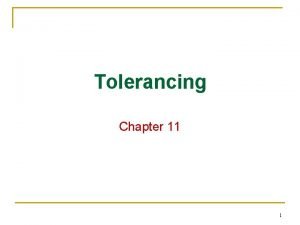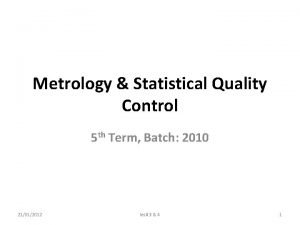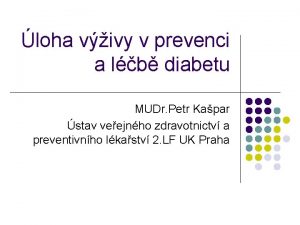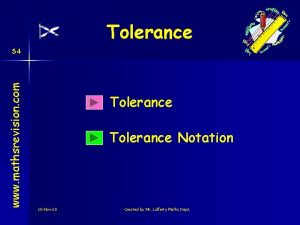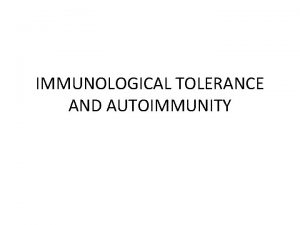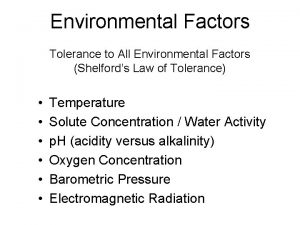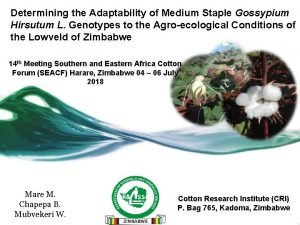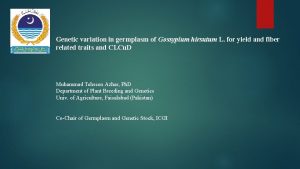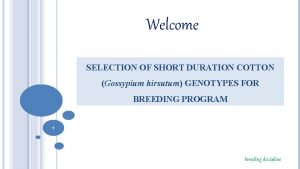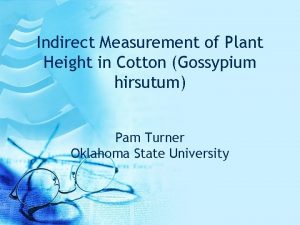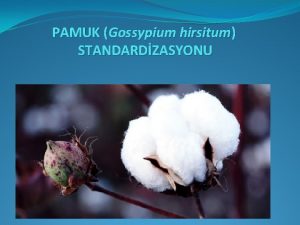Measuring tolerance levels of prereleased Gossypium hirsutum L


















- Slides: 18

Measuring tolerance levels of pre-released Gossypium hirsutum L. Genotypes to Verticillium dahliae Kleb. Fredy Musiniwa Washington Mubvekeri Cotton Research Institute P. Bag 765 Kadoma

Introduction ü Verticillium wilt is one of the most important diseases of cotton which affects yield and fibre quality in cotton worldwide (Karademir et al. , 2010). ü The disease is caused by a soil borne fungus called Verticillium dahliae Kleb ü Once verticillium wilt is introduced into the field, eradicating it is difficult because of its saprophytic ability

…Introduction ü there is no effective chemical control for the disease. ü the use of tolerant cultivars is of great importance in controlling the disease. ü Measuring V. wilt tolerance levels in new cotton genotypes is one of the major breeding goals at Cotton Research institute

Objective üTo determine tolerance levels of new cotton genotypes to verticillium wilt.

Materials and Methods ü Study site ü Cotton Research Institute ü 2 Experiments from MSHV breeding programs ü Treatments- 12 cotton genotypes ü Experimental Design- RCBD with 3 Reps ü Plot size- single row of 5. 4 m ü Measurements- %incidence, severity and seed cotton yield

Materials and Methods ü Infected plants were tagged with knitting wool of different colours from the period of February up to May. ü Percentage incidence was calculated per every plot at the end of the season ü Table 1. Scoring system for percentage incidence % Incidence 0% - 9% Disease Rating Symbol Highly HR Resistant 10% - 19% Resistant R 20% - 29% Tolerant T >30% Susceptible S

Materials and Methods ü Vascular browning was determined by cutting each plant cross sectionally after harvesting. ü Yield was measured per plot at the end of the season.

Materials and methods Fig 1: Vascular browning index for assessing disease severity ü 0 = no discolouration ü 1 = discolouration restricted to small spots or an area less than 5% of the stem cross section ü 2 = discolouration of between 5% and 20% of the stem cross section ü 3 = discolouration of between 20% and 40% of the stem cross section ü 4 = greater than 40% vascular discolouration of the stem cross section Source – (Australian Cotton CRC. 2008. )

Materials and Methods Data analysis ü Data on Incidence and severity was transformed using Arcsine and square root transformations respectively. ü Anova was conducted using Genstat 14 th edition ü Mean separation was done using the Duncan Multiple Range Test at 5% level

Results and Discussions

Table 2: Verticillium wilt incidence, in MSHV 1 trial conducted at CRI during 2015 -16 seasons. 70 % Disease Incidence 60 50 40 30 2014 -15 2015 -16 20 10 Cotton Genotypes 601 -1 81 1 30 M Q -3 01 65 5 - -9 105 93 M S 1 CR I- 3 -2 99 6 - 56 56 2 - 00 -9 -1 65 101 3 85 BC 14 93 SZ 51 -0 97 K 6 02 0

Table 3: Verticillium wilt severity and yield in MSHV 1 trial conducted at CRI during 2015 -16 seasons. Season 2015 2016 2015 -16 Genotype Disease severity index Yield Kg/ha K 602 1. 132 b 0. 300 ab 2131 97 -05 -1 1. 527 c 0. 800 bc 2075 SZ 9314 1. 311 bc 0. 200 a 1467 BC 853 1. 125 b 0. 333 ab 1570 651 -01 -1 1. 262 bc 0. 533 ab 1041 562 -00 -9 0. 812 a 0. 567 ab 1609 566 -99 -23 1. 190 b 1. 100 c 1401 CRI-MS-1 1. 191 b 0. 767 bc 1645 931 -05 -9 1. 435 bc 0. 533 ab 1279 665 -01 -3 1. 398 bc 0. 733 abc 1739 QM 301 1. 168 b 0. 333 ab 2052 816 -01 -1 1. 188 b 0. 400 ab 1094 Grand mean 0. 778 0. 6 1592 P value 0. 008 0. 029 0. 212 CV 14. 2 31 29

Medium Staple Middle Veld Varieties MSHV 4

Table 3: Verticillium wilt incidence, severity and yield in MSHV 4 trial conducted at CRI during 2015 -16 seasons. 80 70 50 40 30 2014 -15 2015 -16 20 10 Cotton Genotypes -3 05 8 - 93 Q M 30 1 1 CR IM S- -9 05 96 TN 0 - 94 -1 0 -1 28 205 91 01 864 96 GN -4 8 (b )- 5 - -3 00 2 - 93 91 705 -7 3 85 BC 02 0 K 6 % Disease Incidence 60

Table 3: Verticillium wilt severity and yield in MSHV 4 trial conducted at CRI during 2015 -16 seasons. Season 2015 2016 Genotype Disease severity index Yield Kg/ha K 602 1. 00 ab 0. 700 3880 c 1142 abc BC 853 1. 733 bcd 1. 000 1028 ab 846 ab 917 -05 -7 1. 900 cd 0. 900 1654 ab 988 ab 932 -00 -3 0. 567 a 0. 900 2386 bc 1679 c GN 96(b)-05 -8 1. 167 abc 0. 400 2438 bc 1228 bc 648 -01 -4 1. 033 ab 0. 400 3687 b 1377 bc 912 -05 -1 2. 233 d 0. 600 213 a 633 a 280 -94 -10 1. 800 bcd 0. 400 1160 ab 886 ab TN 96 -05 -9 1. 967 cd 0. 400 1718 ab 1392 bc CRI-MS-1 1. 233 abc 1. 100 1790 ab 1269 bc QM 301 1. 267 abc 1. 000 1247 ab 1358 bc 938 -05 -3 2. 167 d 0. 500 117 a 957 ab Grand mean 1. 506 0. 700 1609 1146 P value 0. 002 0. 099 0. 002 0. 018 CV 29. 2 31 33 26. 4

Conclusion ü Verticillium wilt screening indicated that varieties had different tolerant levels to the disease. ü Most genotypes which were tolerant to the disease produced high yields. ü MSHV 1 -562 -00 -9 ü MSHV 6 -932 -00 -3, GN 96(b)-05 -8 and 648 -01 -4

Recommendations • Genotypes GN 96(b)-05 -8, 932 -00 -3, 648 -01 -4 and 562 -00 -9 are recommended for further breeding advancement. • Further research to determine the mode of tolerance

The end Thank You!!!
 Unilateral tolerance and bilateral tolerance
Unilateral tolerance and bilateral tolerance Central tolerance and peripheral tolerance
Central tolerance and peripheral tolerance What is costa's level of thinking
What is costa's level of thinking Tip dbt
Tip dbt 25f7 tolerance
25f7 tolerance Truth and tolerance dallin h. oaks
Truth and tolerance dallin h. oaks Teaching tolerance
Teaching tolerance Porušená glukozová tolerance
Porušená glukozová tolerance Stakeholder tolerance
Stakeholder tolerance Navy zero tolerance drug policy
Navy zero tolerance drug policy Limit fit tolerance
Limit fit tolerance Geometrical symbols
Geometrical symbols Tolerance maths
Tolerance maths Immunological tolerance
Immunological tolerance Shelford's law of tolerance
Shelford's law of tolerance Mpi fault tolerance
Mpi fault tolerance Fault tolerance
Fault tolerance 12g6 tolerance
12g6 tolerance Tolerance range in biology
Tolerance range in biology
